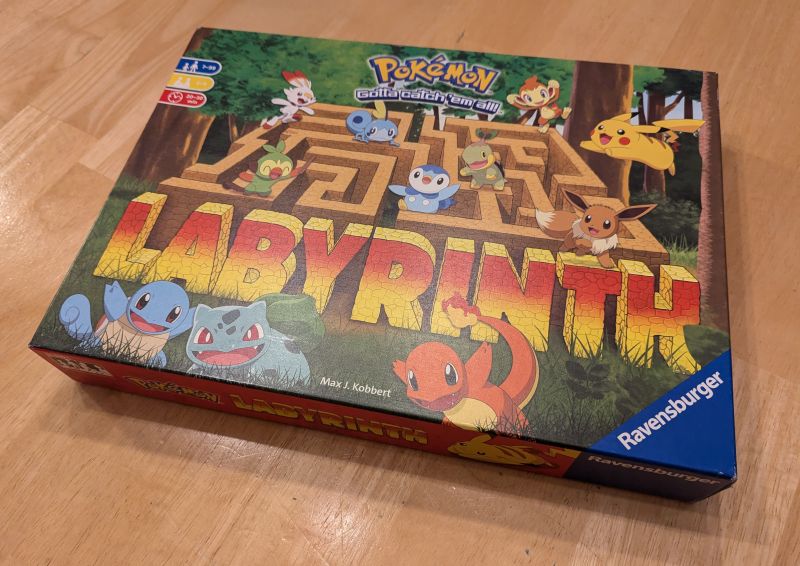
I enjoy playing board games but am known to complain about never playing them (which isn’t even true). So, with the new year, I’ve decided to play 52 different board games (which includes card games and TTRPGs in my mind) and review them here. Perhaps one of you will find them useful, but mostly it will give me some motivation to actually play some games. To start this series, I chose a simple but fun game: Pokemon Labyrinth by Ravensburger. I picked this up from the clearance section at Barnes & Noble for $15 to play with my younger kids, both of whom are still very into Pokemon. Although my daughter was more interested in playing with the dog, my youngest son was game.
Premise
The premise of this game is that you are a pokemon attempting to capture other pokemon within an ever-shifting labyrinth. Honestly, I’m not sure why each player standee is a pokemon and not a trainer, which would make more sense, but we’ll just have to suspend our disbelief. Maybe we’re just trying to free our fellow pokemon from their ancient Greek prison.
Components
Quality: 4/5 (quite nice), Quantity: 2/5 (not too much)
There isn’t really too much to this game. It contains a folded board, four player standees with plastic bases, 24 pokeball cards, and 34 labyrinth tiles. All the components are thick cardboard and seemingly well made. No complaints!
Setup
Complexity: 1/5 (quick and easy)
Setting up to play is super easy. Each player chooses their standee and puts it on the corner with same color. The pokeball cards are shuffled and equally divided between the players in singular stacks. Labyrinth tiles are randomly placed on the board with one remaining. Of note is that the board has 16 permanent tiles glued to it; you place the loose tiles between them and those are the tiles that shift and move during the game. That’s it!

Rules
Players: 2-4 (more is better), Time: 20 minutes (quick)
Similar to setup, the rules are simple. Youngest player starts the game and turns are taken clockwise from them. Each player looks at the top pokeball card in their stack; that pokemon is their current target they have to reach with their standee. Each player, during their turn, first inserts the left-out labyrinth tile into the labyrinth at one of the arrows marked on the edge of the board; the tile that pops out on the other side will be used by the next player.
Then, the current player may choose to move their standee as far as they have an unbroken path. If they land on their target pokemon, they turn the corresponding pokeball face-up in front of them and look at the next. If their player standee “falls off” the labyrinth due to moving tiles, they show up on the opposite side of the row (where the tile was inserted). More than one player standee may be on a tile. First to capture all their pokemon wins!
What I Liked
I enjoyed a few things about this game. First, it is very simple, which makes it easy to teach and quick to start playing. Second, the game forces you to consider how you alter the maze and move your standee independently. Rather than trying to force a direct path to your target tile, I found a lot of success in finding one or two openings that allowed you to reach it through often-convoluted and circuitous paths. There is no limit on how far your standee can move in a turn, after all.
What Could Be Better
My main issue with the game is that it feels like there is supposed to be a mischievous angle where you can alter the maze to foil your opponent’s plans. But, given how random the maze is, and that you don’t know what your opponent’s target it, you seem to help them as much as foil them. It makes the game more random, which may be a boon to younger players, but it does feel like you lose some strategy there. I suppose you could play it so all players know who their opponent’s target pokemon is in order to add a more cutthroat element.
Other Notes
Another helpful variant for younger players is to let them see all their target pokemon at once, instead of one-by-one. My son had a difficult time getting to his targets and I think he would have enjoyed it more if he could grab whatever was easiest. Plus, it inevitably makes the game shorter (if that’s what you’re into).
Results
In then end, I was the victor, with 12 pokemon caught compared to my son’s 5; I’m sure it stung all the more that I didn’t know the names of most of them (I only learned the first 151 pokemon and remain a purist).
Recommendation
Age: 6+, Fun: 3/5, Replayability: 3/5
A great game to play with your younger kids, but take a pass on it if you just play with adults.